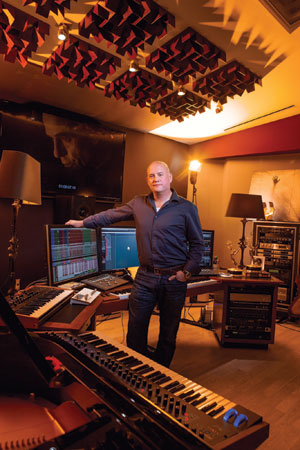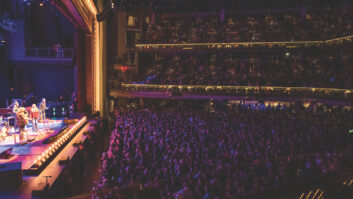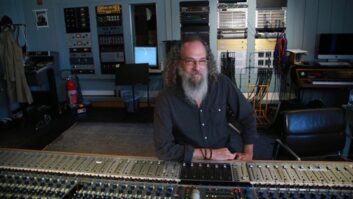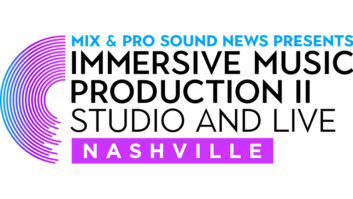
Trevor Morris knows and feels music, and always has, from high school days in London, Ontario, that included being commissioned to write a piece for the Pope’s visit, through today as he is working long days preparing for a second season scoring the popular Vikings (History Channel) and a month from the debut of a new Dracula drama for NBC. He’s scored The Borgias, The Tudors (receiving an Emmy for each) and Pillars of the Earth for TV, and hit big in film with the success of this year’s Olympus Has Fallen. He also writes videogame scores, the latest being Dragon Age: Inquisition from EA/Bioware, due out next year.
But Trevor Morris really knows music technology. He graduated from the prestigious Music Industry Arts program at Fanshawe College in his hometown, then moved to Sounds Interchange and the heart of Toronto’s busy production/engineering community, before getting the writing bug again and scoring TV and radio spots. In 2000 he headed to Los Angeles, to focus on scoring for television and film, only to find himself right back in tech.
Granted, it was high-tech. And cutting-edge. And for some pretty damn fine composers. Morris caught on early as an assistant to Oscar-winning James Newton Howard, running the RADAR recorder and supporting the Euphonix CS3000 writing/mix room as it evolved quite quickly into a modern production environment, with emphasis on traditional orchestral recording, sample-based creations/augmentations and interconnectivity to aid in workflow and delivery. From there he moved to Oscar-winning Hans Zimmer’s then-Media Ventures, now Remote Control Productions, where, he says, he “received his Ph.D.”
“I didn’t realize at the time how much my technical skills would benefit me in the composing world,” Morris says. “My brain is wired both ways, and I’m glad for that. Hans was among the first guys in Hollywood who didn’t write on pencil and paper and used the computer as an instrument. He was a pioneer in a lot of ways for orchestral sampling. He did his own library of sampled instruments before anyone else. When he found out about my technical skills, he hired me on the spot.”
For five years Morris was Zimmer’s right-hand tech and an up-and-coming composer in his own right. After developing some solid credits at Remote Control, he set out on his own. He had always had a writing room at home and could afford to book studios all over town, and that’s what he did for a short while—until he decided to build out a red-brick building in Santa Monica, five minutes from his home.

“I had been working in spare bedrooms my whole life,” Morris says. “But everything back in Toronto was facility-based, so it’s what I knew. Always a few writers, producers, composers…you were never alone. I moved to L.A. and was alone for a short while, then I went to work for Hans, where it is very community-driven. A lot of buildings, studios and people all around. So after I started working at home again, I woke up one morning and thought, ‘You know what? I need a community, even if it’s a small community. I need space, and I want a mix room.’ So I set out to build my dream studio: a mix stage, my room, three small rooms for composers or assistants. But the desire for a proper mix room spawned this whole idea.”
The Writing Room
While the System 5-based mix stage is the flagship, the heart of the facility is Morris’ writing room, with its wraparound control center featuring vintage synths (including his original Roland 760), modern controllers, racks of outboard gear, a Euphonix MC Artist controller with 100mm faders (“I perform on those faders”), Cubase for writing and Pro Tools for recording, and three PMC IB2 monitors across the front with M&K satellites for the surrounds. An iPad running Lemur sits front and center, beneath the three displays. And there’s a rare Yamaha S6 baby grand set to his left, always miked and ready with a Schoeps CMC6/Mk IV and Apollo stereo ribbon.
Everything he needs to create a virtual score is literally within reach, though he inevitably reaches for his outboard reverbs and effects. The tech-geek comes out as he rattles off specific combinations: “The Bricasti M7 is one of the cleanest reverbs ever made—stereo on piano…The Lexicon PCM96 is great as a 2-in, 5-out unit for stereo samples—I have two for the 5.1…The Grace M201 with their A/D converter is one of the best combos I’ve ever heard—we use that with the Schoeps mics on piano…The Millennia stereo pre is perfect for the Apollo mic to get some distance on the piano…And the API 500 EQ that I grew up on—you put that across the SSL stereo bus when I was growing up, and it’s great for adding sparkle over the piano, 2 dB at 16k. And I just love hardware reverbs. The tail is perfectly in tune, no dithering. They take multiple sample libraries and bring them into the same environment. They bring the glue.”
While composing, Morris says that he is always mixing, considering it the same as responding to the dynamics in a score. When you tell a violin player to crescendo, he says, that’s a mix move. When he is performing a sampled violin, he is mixing against the cello. Still, once he is close, he saves to the network, where it is picked up by his house engineer, Phil McGowan, whom Morris says has become something of a co-producer on a lot of his work.
The Mix Room
The Avid System 5 mix stage features identical PMC IB2/M&K monitoring and was designed with a living room feel in mind, including bookshelves, a coffee table and a couch; no producer’s desk. Solo instruments are often overdubbed right in the room. It’s comfortable enough that directors regularly stop by.
From Morris’ writing room, everything flows into dual Pro Tools|HDX systems, nicknamed Orchestra Rig and Print Rig. The Orchestra Rig handles all source material, including live orchestra, choir, synth bass, guitar, samples, etc., and feeds the System 5, with sends and returns to Pro Tools for plug-ins and reverbs and whatnot. That in turn is mixed in surround, stem format, to the Print Rig, which runs video and serves as the recorder. To the post-production houses, they deliver a final 5.1 mix, a final stereo crashdown, then, depending on the project, between 8 to 12 surround stems—5.1 strings, 5.0 choir and the like.
“Building a mix room that was both accurate and balanced for critical mixing, while simultaneously being an inspiring environment for playbacks, was key for both Trevor and myself,” McGowan says. “It’s always a challenge to design and tune a midsize room with mid-field monitoring that will translate properly to the large theatrical dub stages that we frequently deliver to. A combination of custom diffusion, absorption and bass trapping in concert with the monitor calibrating set on our XTA processors results in a mix studio that translates very well to every dub we have delivered to. It’s an honest-sounding room and will truly let you know when something is wrong with your mix.”
The combination of technical chops and a natural, self-taught musical ability has served Morris well. He speaks both languages fluently. Morris is living the L.A. dream that he set out for, and now he has a place to call home.







